Foundations of Business and Tourism
VerifiedAdded on 2023/06/18
|9
|2643
|317
AI Summary
This article discusses the management model of Cumberland Hotel, a hierarchical structure model, and its underlying theories. It also covers the macro environment analysis of the hotel industry using PESTLE analysis, focusing on political, economic, and technological factors. The article concludes that businesses in the tourism industry operate in a dynamic macro environment.
Contribute Materials
Your contribution can guide someone’s learning journey. Share your
documents today.
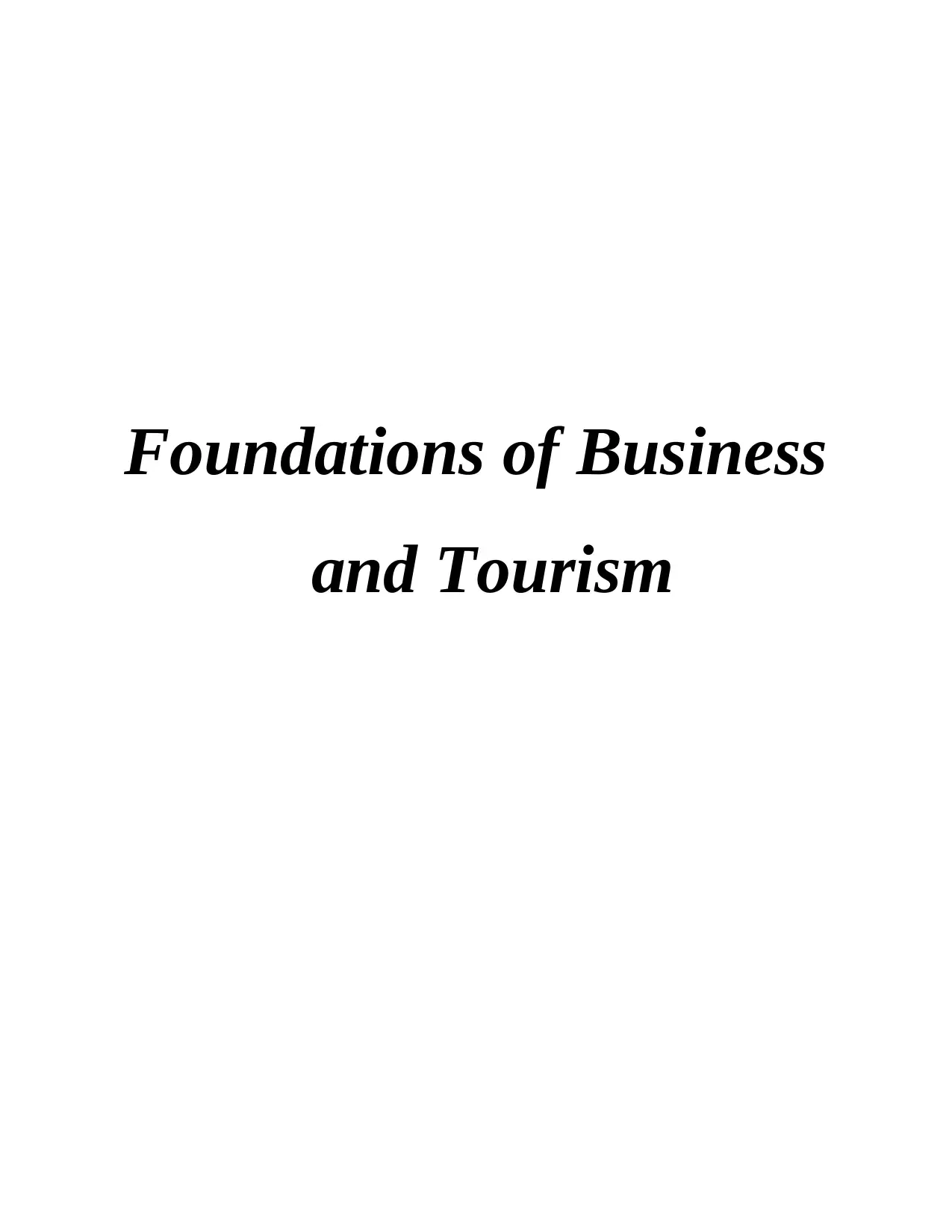
Foundations of Business
and Tourism
and Tourism
Secure Best Marks with AI Grader
Need help grading? Try our AI Grader for instant feedback on your assignments.
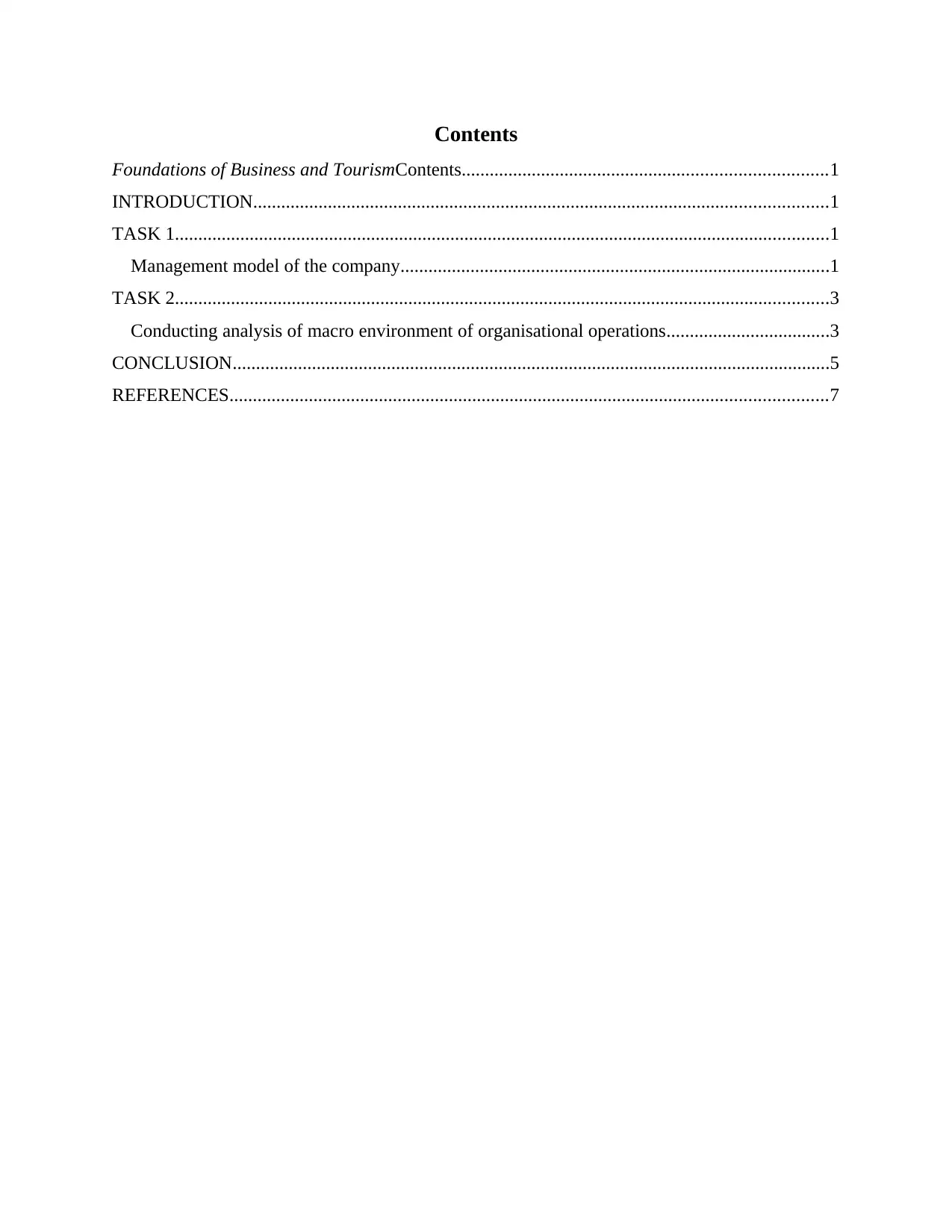
Contents
Foundations of Business and TourismContents..............................................................................1
INTRODUCTION...........................................................................................................................1
TASK 1............................................................................................................................................1
Management model of the company............................................................................................1
TASK 2............................................................................................................................................3
Conducting analysis of macro environment of organisational operations...................................3
CONCLUSION................................................................................................................................5
REFERENCES................................................................................................................................7
Foundations of Business and TourismContents..............................................................................1
INTRODUCTION...........................................................................................................................1
TASK 1............................................................................................................................................1
Management model of the company............................................................................................1
TASK 2............................................................................................................................................3
Conducting analysis of macro environment of organisational operations...................................3
CONCLUSION................................................................................................................................5
REFERENCES................................................................................................................................7
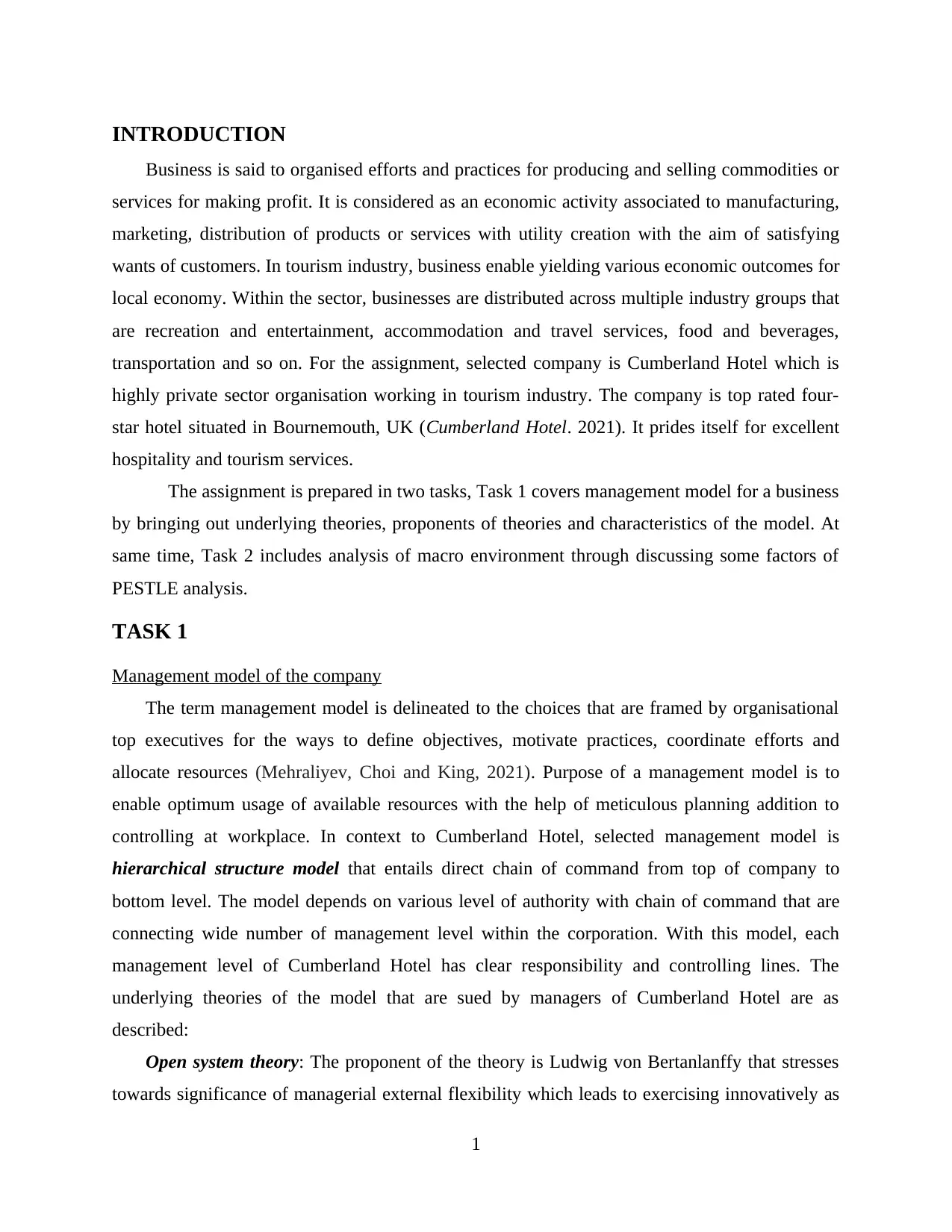
INTRODUCTION
Business is said to organised efforts and practices for producing and selling commodities or
services for making profit. It is considered as an economic activity associated to manufacturing,
marketing, distribution of products or services with utility creation with the aim of satisfying
wants of customers. In tourism industry, business enable yielding various economic outcomes for
local economy. Within the sector, businesses are distributed across multiple industry groups that
are recreation and entertainment, accommodation and travel services, food and beverages,
transportation and so on. For the assignment, selected company is Cumberland Hotel which is
highly private sector organisation working in tourism industry. The company is top rated four-
star hotel situated in Bournemouth, UK (Cumberland Hotel. 2021). It prides itself for excellent
hospitality and tourism services.
The assignment is prepared in two tasks, Task 1 covers management model for a business
by bringing out underlying theories, proponents of theories and characteristics of the model. At
same time, Task 2 includes analysis of macro environment through discussing some factors of
PESTLE analysis.
TASK 1
Management model of the company
The term management model is delineated to the choices that are framed by organisational
top executives for the ways to define objectives, motivate practices, coordinate efforts and
allocate resources (Mehraliyev, Choi and King, 2021). Purpose of a management model is to
enable optimum usage of available resources with the help of meticulous planning addition to
controlling at workplace. In context to Cumberland Hotel, selected management model is
hierarchical structure model that entails direct chain of command from top of company to
bottom level. The model depends on various level of authority with chain of command that are
connecting wide number of management level within the corporation. With this model, each
management level of Cumberland Hotel has clear responsibility and controlling lines. The
underlying theories of the model that are sued by managers of Cumberland Hotel are as
described:
Open system theory: The proponent of the theory is Ludwig von Bertanlanffy that stresses
towards significance of managerial external flexibility which leads to exercising innovatively as
1
Business is said to organised efforts and practices for producing and selling commodities or
services for making profit. It is considered as an economic activity associated to manufacturing,
marketing, distribution of products or services with utility creation with the aim of satisfying
wants of customers. In tourism industry, business enable yielding various economic outcomes for
local economy. Within the sector, businesses are distributed across multiple industry groups that
are recreation and entertainment, accommodation and travel services, food and beverages,
transportation and so on. For the assignment, selected company is Cumberland Hotel which is
highly private sector organisation working in tourism industry. The company is top rated four-
star hotel situated in Bournemouth, UK (Cumberland Hotel. 2021). It prides itself for excellent
hospitality and tourism services.
The assignment is prepared in two tasks, Task 1 covers management model for a business
by bringing out underlying theories, proponents of theories and characteristics of the model. At
same time, Task 2 includes analysis of macro environment through discussing some factors of
PESTLE analysis.
TASK 1
Management model of the company
The term management model is delineated to the choices that are framed by organisational
top executives for the ways to define objectives, motivate practices, coordinate efforts and
allocate resources (Mehraliyev, Choi and King, 2021). Purpose of a management model is to
enable optimum usage of available resources with the help of meticulous planning addition to
controlling at workplace. In context to Cumberland Hotel, selected management model is
hierarchical structure model that entails direct chain of command from top of company to
bottom level. The model depends on various level of authority with chain of command that are
connecting wide number of management level within the corporation. With this model, each
management level of Cumberland Hotel has clear responsibility and controlling lines. The
underlying theories of the model that are sued by managers of Cumberland Hotel are as
described:
Open system theory: The proponent of the theory is Ludwig von Bertanlanffy that stresses
towards significance of managerial external flexibility which leads to exercising innovatively as
1
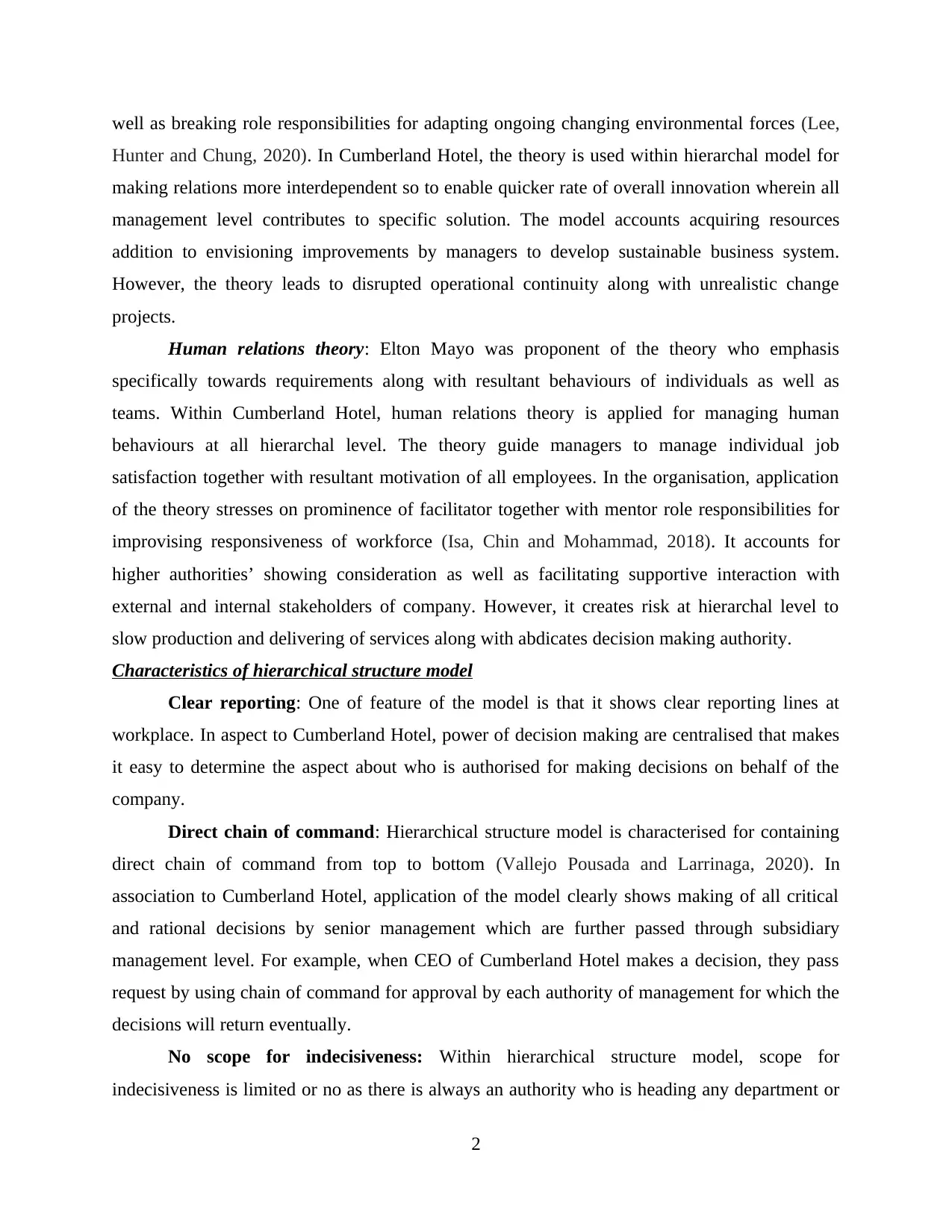
well as breaking role responsibilities for adapting ongoing changing environmental forces (Lee,
Hunter and Chung, 2020). In Cumberland Hotel, the theory is used within hierarchal model for
making relations more interdependent so to enable quicker rate of overall innovation wherein all
management level contributes to specific solution. The model accounts acquiring resources
addition to envisioning improvements by managers to develop sustainable business system.
However, the theory leads to disrupted operational continuity along with unrealistic change
projects.
Human relations theory: Elton Mayo was proponent of the theory who emphasis
specifically towards requirements along with resultant behaviours of individuals as well as
teams. Within Cumberland Hotel, human relations theory is applied for managing human
behaviours at all hierarchal level. The theory guide managers to manage individual job
satisfaction together with resultant motivation of all employees. In the organisation, application
of the theory stresses on prominence of facilitator together with mentor role responsibilities for
improvising responsiveness of workforce (Isa, Chin and Mohammad, 2018). It accounts for
higher authorities’ showing consideration as well as facilitating supportive interaction with
external and internal stakeholders of company. However, it creates risk at hierarchal level to
slow production and delivering of services along with abdicates decision making authority.
Characteristics of hierarchical structure model
Clear reporting: One of feature of the model is that it shows clear reporting lines at
workplace. In aspect to Cumberland Hotel, power of decision making are centralised that makes
it easy to determine the aspect about who is authorised for making decisions on behalf of the
company.
Direct chain of command: Hierarchical structure model is characterised for containing
direct chain of command from top to bottom (Vallejo Pousada and Larrinaga, 2020). In
association to Cumberland Hotel, application of the model clearly shows making of all critical
and rational decisions by senior management which are further passed through subsidiary
management level. For example, when CEO of Cumberland Hotel makes a decision, they pass
request by using chain of command for approval by each authority of management for which the
decisions will return eventually.
No scope for indecisiveness: Within hierarchical structure model, scope for
indecisiveness is limited or no as there is always an authority who is heading any department or
2
Hunter and Chung, 2020). In Cumberland Hotel, the theory is used within hierarchal model for
making relations more interdependent so to enable quicker rate of overall innovation wherein all
management level contributes to specific solution. The model accounts acquiring resources
addition to envisioning improvements by managers to develop sustainable business system.
However, the theory leads to disrupted operational continuity along with unrealistic change
projects.
Human relations theory: Elton Mayo was proponent of the theory who emphasis
specifically towards requirements along with resultant behaviours of individuals as well as
teams. Within Cumberland Hotel, human relations theory is applied for managing human
behaviours at all hierarchal level. The theory guide managers to manage individual job
satisfaction together with resultant motivation of all employees. In the organisation, application
of the theory stresses on prominence of facilitator together with mentor role responsibilities for
improvising responsiveness of workforce (Isa, Chin and Mohammad, 2018). It accounts for
higher authorities’ showing consideration as well as facilitating supportive interaction with
external and internal stakeholders of company. However, it creates risk at hierarchal level to
slow production and delivering of services along with abdicates decision making authority.
Characteristics of hierarchical structure model
Clear reporting: One of feature of the model is that it shows clear reporting lines at
workplace. In aspect to Cumberland Hotel, power of decision making are centralised that makes
it easy to determine the aspect about who is authorised for making decisions on behalf of the
company.
Direct chain of command: Hierarchical structure model is characterised for containing
direct chain of command from top to bottom (Vallejo Pousada and Larrinaga, 2020). In
association to Cumberland Hotel, application of the model clearly shows making of all critical
and rational decisions by senior management which are further passed through subsidiary
management level. For example, when CEO of Cumberland Hotel makes a decision, they pass
request by using chain of command for approval by each authority of management for which the
decisions will return eventually.
No scope for indecisiveness: Within hierarchical structure model, scope for
indecisiveness is limited or no as there is always an authority who is heading any department or
2
Secure Best Marks with AI Grader
Need help grading? Try our AI Grader for instant feedback on your assignments.
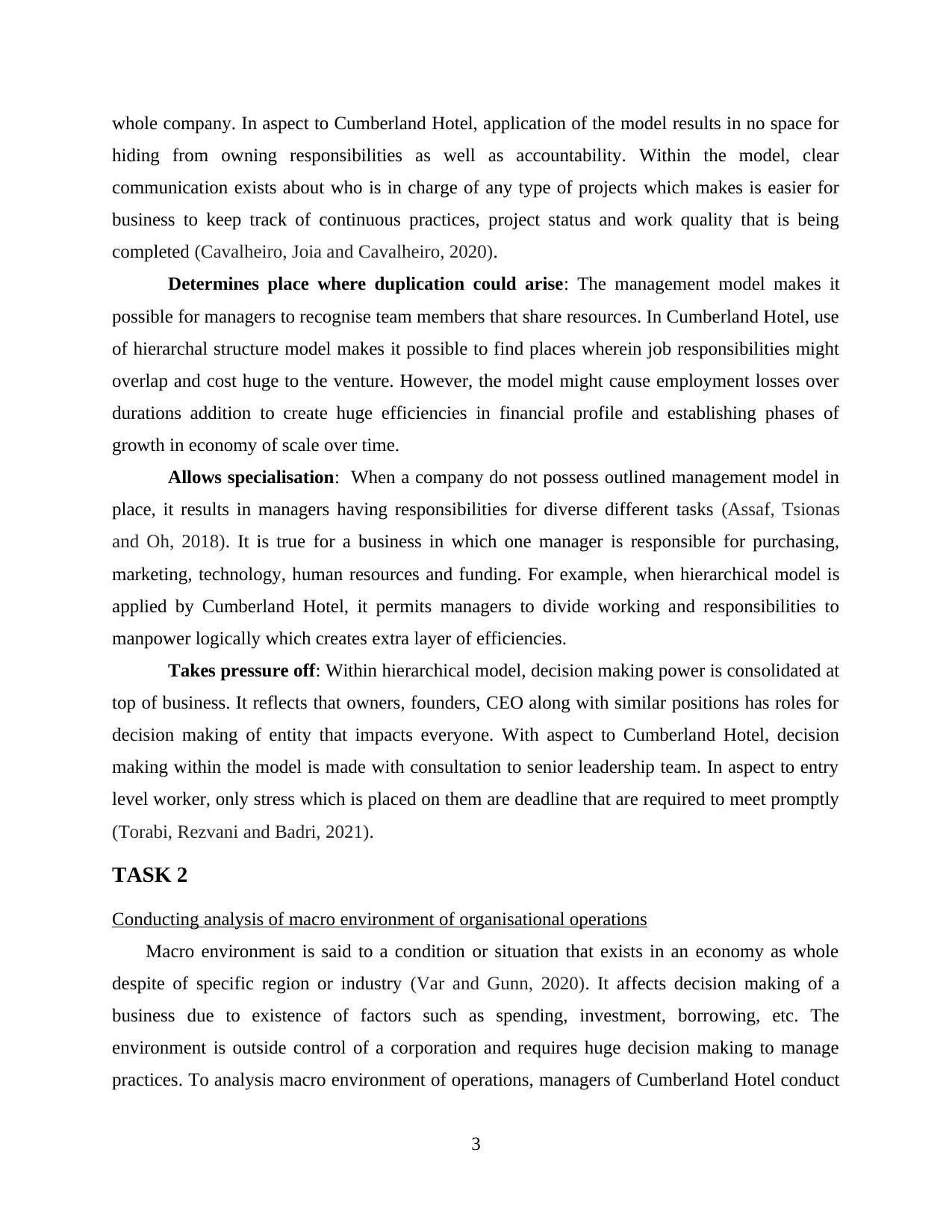
whole company. In aspect to Cumberland Hotel, application of the model results in no space for
hiding from owning responsibilities as well as accountability. Within the model, clear
communication exists about who is in charge of any type of projects which makes is easier for
business to keep track of continuous practices, project status and work quality that is being
completed (Cavalheiro, Joia and Cavalheiro, 2020).
Determines place where duplication could arise: The management model makes it
possible for managers to recognise team members that share resources. In Cumberland Hotel, use
of hierarchal structure model makes it possible to find places wherein job responsibilities might
overlap and cost huge to the venture. However, the model might cause employment losses over
durations addition to create huge efficiencies in financial profile and establishing phases of
growth in economy of scale over time.
Allows specialisation: When a company do not possess outlined management model in
place, it results in managers having responsibilities for diverse different tasks (Assaf, Tsionas
and Oh, 2018). It is true for a business in which one manager is responsible for purchasing,
marketing, technology, human resources and funding. For example, when hierarchical model is
applied by Cumberland Hotel, it permits managers to divide working and responsibilities to
manpower logically which creates extra layer of efficiencies.
Takes pressure off: Within hierarchical model, decision making power is consolidated at
top of business. It reflects that owners, founders, CEO along with similar positions has roles for
decision making of entity that impacts everyone. With aspect to Cumberland Hotel, decision
making within the model is made with consultation to senior leadership team. In aspect to entry
level worker, only stress which is placed on them are deadline that are required to meet promptly
(Torabi, Rezvani and Badri, 2021).
TASK 2
Conducting analysis of macro environment of organisational operations
Macro environment is said to a condition or situation that exists in an economy as whole
despite of specific region or industry (Var and Gunn, 2020). It affects decision making of a
business due to existence of factors such as spending, investment, borrowing, etc. The
environment is outside control of a corporation and requires huge decision making to manage
practices. To analysis macro environment of operations, managers of Cumberland Hotel conduct
3
hiding from owning responsibilities as well as accountability. Within the model, clear
communication exists about who is in charge of any type of projects which makes is easier for
business to keep track of continuous practices, project status and work quality that is being
completed (Cavalheiro, Joia and Cavalheiro, 2020).
Determines place where duplication could arise: The management model makes it
possible for managers to recognise team members that share resources. In Cumberland Hotel, use
of hierarchal structure model makes it possible to find places wherein job responsibilities might
overlap and cost huge to the venture. However, the model might cause employment losses over
durations addition to create huge efficiencies in financial profile and establishing phases of
growth in economy of scale over time.
Allows specialisation: When a company do not possess outlined management model in
place, it results in managers having responsibilities for diverse different tasks (Assaf, Tsionas
and Oh, 2018). It is true for a business in which one manager is responsible for purchasing,
marketing, technology, human resources and funding. For example, when hierarchical model is
applied by Cumberland Hotel, it permits managers to divide working and responsibilities to
manpower logically which creates extra layer of efficiencies.
Takes pressure off: Within hierarchical model, decision making power is consolidated at
top of business. It reflects that owners, founders, CEO along with similar positions has roles for
decision making of entity that impacts everyone. With aspect to Cumberland Hotel, decision
making within the model is made with consultation to senior leadership team. In aspect to entry
level worker, only stress which is placed on them are deadline that are required to meet promptly
(Torabi, Rezvani and Badri, 2021).
TASK 2
Conducting analysis of macro environment of organisational operations
Macro environment is said to a condition or situation that exists in an economy as whole
despite of specific region or industry (Var and Gunn, 2020). It affects decision making of a
business due to existence of factors such as spending, investment, borrowing, etc. The
environment is outside control of a corporation and requires huge decision making to manage
practices. To analysis macro environment of operations, managers of Cumberland Hotel conduct
3
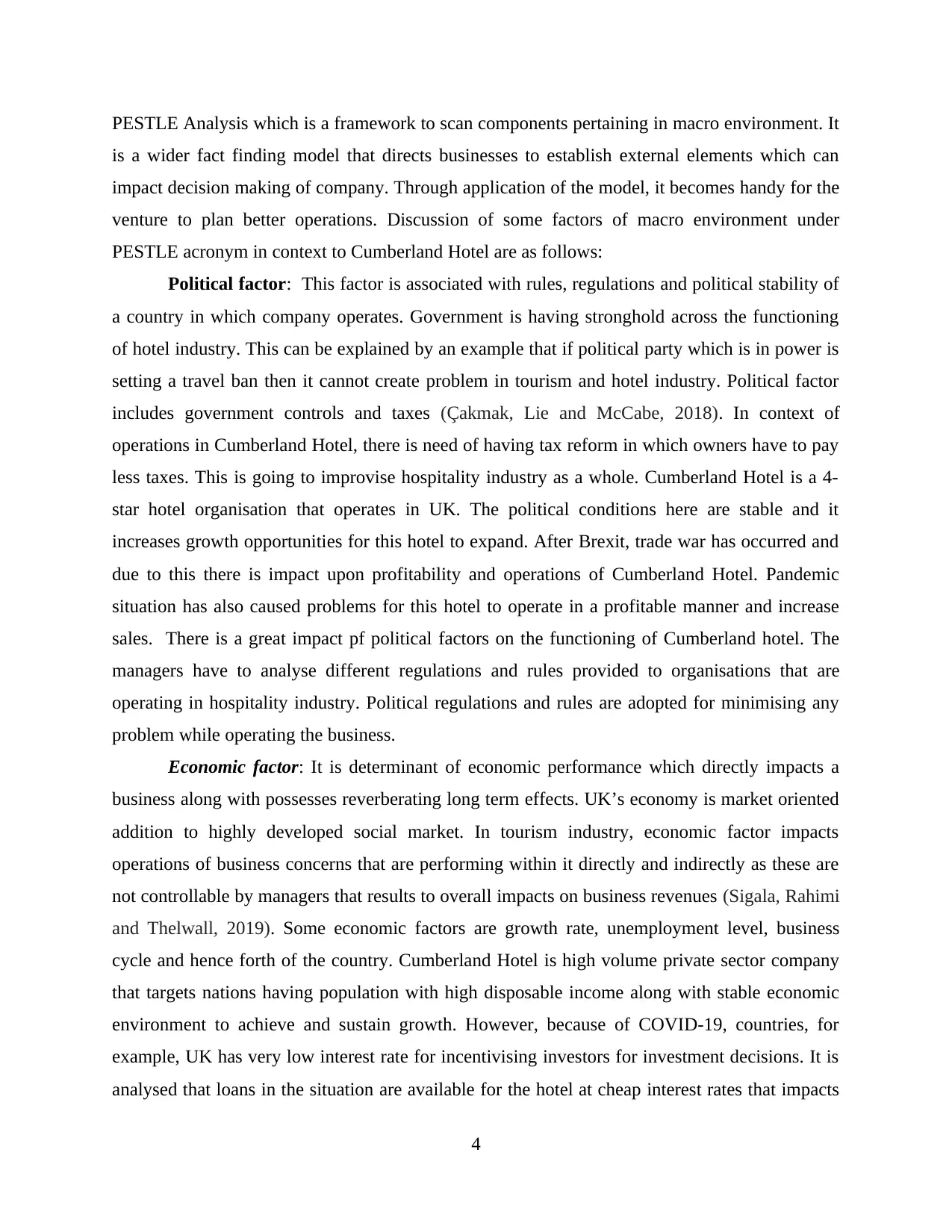
PESTLE Analysis which is a framework to scan components pertaining in macro environment. It
is a wider fact finding model that directs businesses to establish external elements which can
impact decision making of company. Through application of the model, it becomes handy for the
venture to plan better operations. Discussion of some factors of macro environment under
PESTLE acronym in context to Cumberland Hotel are as follows:
Political factor: This factor is associated with rules, regulations and political stability of
a country in which company operates. Government is having stronghold across the functioning
of hotel industry. This can be explained by an example that if political party which is in power is
setting a travel ban then it cannot create problem in tourism and hotel industry. Political factor
includes government controls and taxes (Çakmak, Lie and McCabe, 2018). In context of
operations in Cumberland Hotel, there is need of having tax reform in which owners have to pay
less taxes. This is going to improvise hospitality industry as a whole. Cumberland Hotel is a 4-
star hotel organisation that operates in UK. The political conditions here are stable and it
increases growth opportunities for this hotel to expand. After Brexit, trade war has occurred and
due to this there is impact upon profitability and operations of Cumberland Hotel. Pandemic
situation has also caused problems for this hotel to operate in a profitable manner and increase
sales. There is a great impact pf political factors on the functioning of Cumberland hotel. The
managers have to analyse different regulations and rules provided to organisations that are
operating in hospitality industry. Political regulations and rules are adopted for minimising any
problem while operating the business.
Economic factor: It is determinant of economic performance which directly impacts a
business along with possesses reverberating long term effects. UK’s economy is market oriented
addition to highly developed social market. In tourism industry, economic factor impacts
operations of business concerns that are performing within it directly and indirectly as these are
not controllable by managers that results to overall impacts on business revenues (Sigala, Rahimi
and Thelwall, 2019). Some economic factors are growth rate, unemployment level, business
cycle and hence forth of the country. Cumberland Hotel is high volume private sector company
that targets nations having population with high disposable income along with stable economic
environment to achieve and sustain growth. However, because of COVID-19, countries, for
example, UK has very low interest rate for incentivising investors for investment decisions. It is
analysed that loans in the situation are available for the hotel at cheap interest rates that impacts
4
is a wider fact finding model that directs businesses to establish external elements which can
impact decision making of company. Through application of the model, it becomes handy for the
venture to plan better operations. Discussion of some factors of macro environment under
PESTLE acronym in context to Cumberland Hotel are as follows:
Political factor: This factor is associated with rules, regulations and political stability of
a country in which company operates. Government is having stronghold across the functioning
of hotel industry. This can be explained by an example that if political party which is in power is
setting a travel ban then it cannot create problem in tourism and hotel industry. Political factor
includes government controls and taxes (Çakmak, Lie and McCabe, 2018). In context of
operations in Cumberland Hotel, there is need of having tax reform in which owners have to pay
less taxes. This is going to improvise hospitality industry as a whole. Cumberland Hotel is a 4-
star hotel organisation that operates in UK. The political conditions here are stable and it
increases growth opportunities for this hotel to expand. After Brexit, trade war has occurred and
due to this there is impact upon profitability and operations of Cumberland Hotel. Pandemic
situation has also caused problems for this hotel to operate in a profitable manner and increase
sales. There is a great impact pf political factors on the functioning of Cumberland hotel. The
managers have to analyse different regulations and rules provided to organisations that are
operating in hospitality industry. Political regulations and rules are adopted for minimising any
problem while operating the business.
Economic factor: It is determinant of economic performance which directly impacts a
business along with possesses reverberating long term effects. UK’s economy is market oriented
addition to highly developed social market. In tourism industry, economic factor impacts
operations of business concerns that are performing within it directly and indirectly as these are
not controllable by managers that results to overall impacts on business revenues (Sigala, Rahimi
and Thelwall, 2019). Some economic factors are growth rate, unemployment level, business
cycle and hence forth of the country. Cumberland Hotel is high volume private sector company
that targets nations having population with high disposable income along with stable economic
environment to achieve and sustain growth. However, because of COVID-19, countries, for
example, UK has very low interest rate for incentivising investors for investment decisions. It is
analysed that loans in the situation are available for the hotel at cheap interest rates that impacts
4
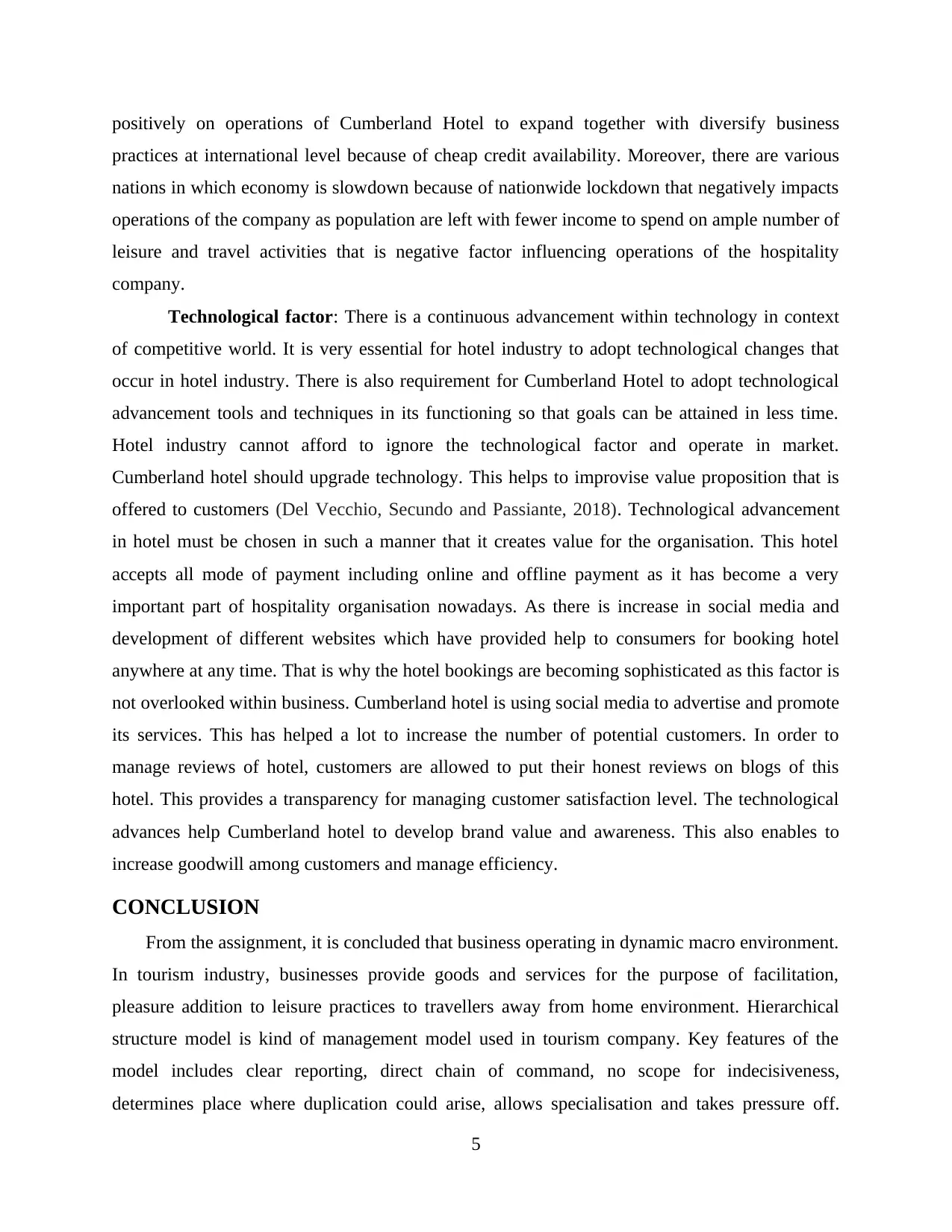
positively on operations of Cumberland Hotel to expand together with diversify business
practices at international level because of cheap credit availability. Moreover, there are various
nations in which economy is slowdown because of nationwide lockdown that negatively impacts
operations of the company as population are left with fewer income to spend on ample number of
leisure and travel activities that is negative factor influencing operations of the hospitality
company.
Technological factor: There is a continuous advancement within technology in context
of competitive world. It is very essential for hotel industry to adopt technological changes that
occur in hotel industry. There is also requirement for Cumberland Hotel to adopt technological
advancement tools and techniques in its functioning so that goals can be attained in less time.
Hotel industry cannot afford to ignore the technological factor and operate in market.
Cumberland hotel should upgrade technology. This helps to improvise value proposition that is
offered to customers (Del Vecchio, Secundo and Passiante, 2018). Technological advancement
in hotel must be chosen in such a manner that it creates value for the organisation. This hotel
accepts all mode of payment including online and offline payment as it has become a very
important part of hospitality organisation nowadays. As there is increase in social media and
development of different websites which have provided help to consumers for booking hotel
anywhere at any time. That is why the hotel bookings are becoming sophisticated as this factor is
not overlooked within business. Cumberland hotel is using social media to advertise and promote
its services. This has helped a lot to increase the number of potential customers. In order to
manage reviews of hotel, customers are allowed to put their honest reviews on blogs of this
hotel. This provides a transparency for managing customer satisfaction level. The technological
advances help Cumberland hotel to develop brand value and awareness. This also enables to
increase goodwill among customers and manage efficiency.
CONCLUSION
From the assignment, it is concluded that business operating in dynamic macro environment.
In tourism industry, businesses provide goods and services for the purpose of facilitation,
pleasure addition to leisure practices to travellers away from home environment. Hierarchical
structure model is kind of management model used in tourism company. Key features of the
model includes clear reporting, direct chain of command, no scope for indecisiveness,
determines place where duplication could arise, allows specialisation and takes pressure off.
5
practices at international level because of cheap credit availability. Moreover, there are various
nations in which economy is slowdown because of nationwide lockdown that negatively impacts
operations of the company as population are left with fewer income to spend on ample number of
leisure and travel activities that is negative factor influencing operations of the hospitality
company.
Technological factor: There is a continuous advancement within technology in context
of competitive world. It is very essential for hotel industry to adopt technological changes that
occur in hotel industry. There is also requirement for Cumberland Hotel to adopt technological
advancement tools and techniques in its functioning so that goals can be attained in less time.
Hotel industry cannot afford to ignore the technological factor and operate in market.
Cumberland hotel should upgrade technology. This helps to improvise value proposition that is
offered to customers (Del Vecchio, Secundo and Passiante, 2018). Technological advancement
in hotel must be chosen in such a manner that it creates value for the organisation. This hotel
accepts all mode of payment including online and offline payment as it has become a very
important part of hospitality organisation nowadays. As there is increase in social media and
development of different websites which have provided help to consumers for booking hotel
anywhere at any time. That is why the hotel bookings are becoming sophisticated as this factor is
not overlooked within business. Cumberland hotel is using social media to advertise and promote
its services. This has helped a lot to increase the number of potential customers. In order to
manage reviews of hotel, customers are allowed to put their honest reviews on blogs of this
hotel. This provides a transparency for managing customer satisfaction level. The technological
advances help Cumberland hotel to develop brand value and awareness. This also enables to
increase goodwill among customers and manage efficiency.
CONCLUSION
From the assignment, it is concluded that business operating in dynamic macro environment.
In tourism industry, businesses provide goods and services for the purpose of facilitation,
pleasure addition to leisure practices to travellers away from home environment. Hierarchical
structure model is kind of management model used in tourism company. Key features of the
model includes clear reporting, direct chain of command, no scope for indecisiveness,
determines place where duplication could arise, allows specialisation and takes pressure off.
5
Paraphrase This Document
Need a fresh take? Get an instant paraphrase of this document with our AI Paraphraser
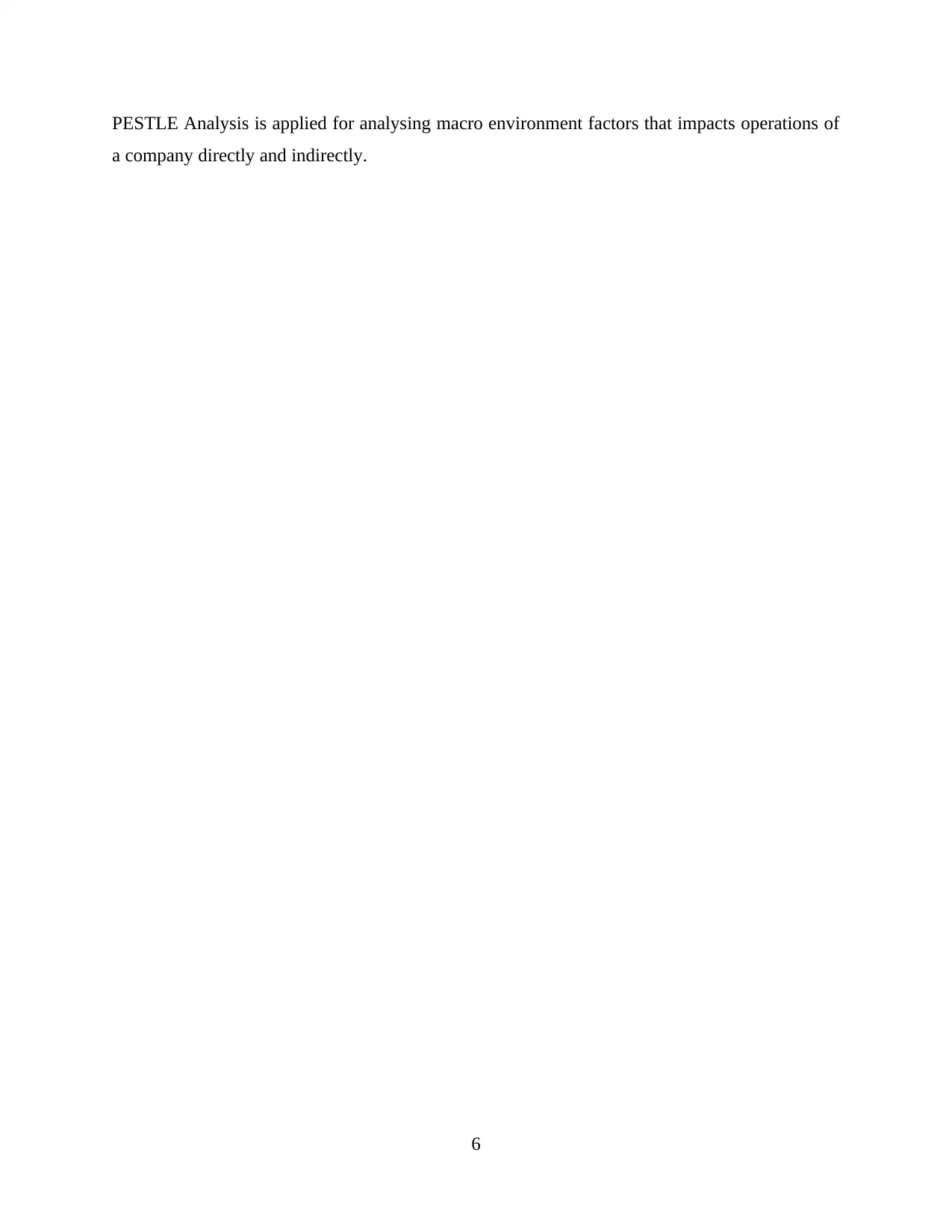
PESTLE Analysis is applied for analysing macro environment factors that impacts operations of
a company directly and indirectly.
6
a company directly and indirectly.
6
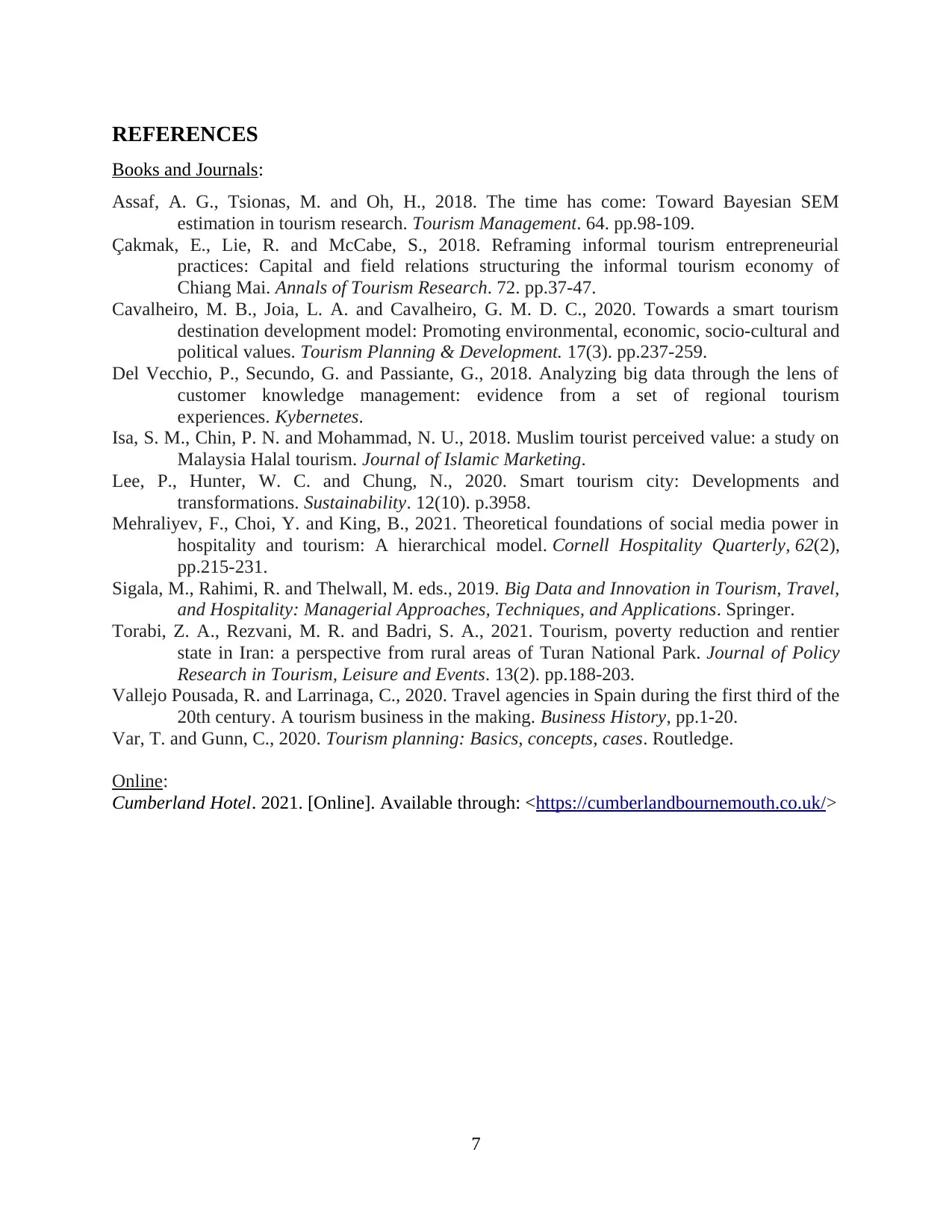
REFERENCES
Books and Journals:
Assaf, A. G., Tsionas, M. and Oh, H., 2018. The time has come: Toward Bayesian SEM
estimation in tourism research. Tourism Management. 64. pp.98-109.
Çakmak, E., Lie, R. and McCabe, S., 2018. Reframing informal tourism entrepreneurial
practices: Capital and field relations structuring the informal tourism economy of
Chiang Mai. Annals of Tourism Research. 72. pp.37-47.
Cavalheiro, M. B., Joia, L. A. and Cavalheiro, G. M. D. C., 2020. Towards a smart tourism
destination development model: Promoting environmental, economic, socio-cultural and
political values. Tourism Planning & Development. 17(3). pp.237-259.
Del Vecchio, P., Secundo, G. and Passiante, G., 2018. Analyzing big data through the lens of
customer knowledge management: evidence from a set of regional tourism
experiences. Kybernetes.
Isa, S. M., Chin, P. N. and Mohammad, N. U., 2018. Muslim tourist perceived value: a study on
Malaysia Halal tourism. Journal of Islamic Marketing.
Lee, P., Hunter, W. C. and Chung, N., 2020. Smart tourism city: Developments and
transformations. Sustainability. 12(10). p.3958.
Mehraliyev, F., Choi, Y. and King, B., 2021. Theoretical foundations of social media power in
hospitality and tourism: A hierarchical model. Cornell Hospitality Quarterly, 62(2),
pp.215-231.
Sigala, M., Rahimi, R. and Thelwall, M. eds., 2019. Big Data and Innovation in Tourism, Travel,
and Hospitality: Managerial Approaches, Techniques, and Applications. Springer.
Torabi, Z. A., Rezvani, M. R. and Badri, S. A., 2021. Tourism, poverty reduction and rentier
state in Iran: a perspective from rural areas of Turan National Park. Journal of Policy
Research in Tourism, Leisure and Events. 13(2). pp.188-203.
Vallejo Pousada, R. and Larrinaga, C., 2020. Travel agencies in Spain during the first third of the
20th century. A tourism business in the making. Business History, pp.1-20.
Var, T. and Gunn, C., 2020. Tourism planning: Basics, concepts, cases. Routledge.
Online:
Cumberland Hotel. 2021. [Online]. Available through: <https://cumberlandbournemouth.co.uk/>
7
Books and Journals:
Assaf, A. G., Tsionas, M. and Oh, H., 2018. The time has come: Toward Bayesian SEM
estimation in tourism research. Tourism Management. 64. pp.98-109.
Çakmak, E., Lie, R. and McCabe, S., 2018. Reframing informal tourism entrepreneurial
practices: Capital and field relations structuring the informal tourism economy of
Chiang Mai. Annals of Tourism Research. 72. pp.37-47.
Cavalheiro, M. B., Joia, L. A. and Cavalheiro, G. M. D. C., 2020. Towards a smart tourism
destination development model: Promoting environmental, economic, socio-cultural and
political values. Tourism Planning & Development. 17(3). pp.237-259.
Del Vecchio, P., Secundo, G. and Passiante, G., 2018. Analyzing big data through the lens of
customer knowledge management: evidence from a set of regional tourism
experiences. Kybernetes.
Isa, S. M., Chin, P. N. and Mohammad, N. U., 2018. Muslim tourist perceived value: a study on
Malaysia Halal tourism. Journal of Islamic Marketing.
Lee, P., Hunter, W. C. and Chung, N., 2020. Smart tourism city: Developments and
transformations. Sustainability. 12(10). p.3958.
Mehraliyev, F., Choi, Y. and King, B., 2021. Theoretical foundations of social media power in
hospitality and tourism: A hierarchical model. Cornell Hospitality Quarterly, 62(2),
pp.215-231.
Sigala, M., Rahimi, R. and Thelwall, M. eds., 2019. Big Data and Innovation in Tourism, Travel,
and Hospitality: Managerial Approaches, Techniques, and Applications. Springer.
Torabi, Z. A., Rezvani, M. R. and Badri, S. A., 2021. Tourism, poverty reduction and rentier
state in Iran: a perspective from rural areas of Turan National Park. Journal of Policy
Research in Tourism, Leisure and Events. 13(2). pp.188-203.
Vallejo Pousada, R. and Larrinaga, C., 2020. Travel agencies in Spain during the first third of the
20th century. A tourism business in the making. Business History, pp.1-20.
Var, T. and Gunn, C., 2020. Tourism planning: Basics, concepts, cases. Routledge.
Online:
Cumberland Hotel. 2021. [Online]. Available through: <https://cumberlandbournemouth.co.uk/>
7
1 out of 9
Related Documents
Your All-in-One AI-Powered Toolkit for Academic Success.
+13062052269
info@desklib.com
Available 24*7 on WhatsApp / Email
![[object Object]](/_next/static/media/star-bottom.7253800d.svg)
Unlock your academic potential
© 2024 | Zucol Services PVT LTD | All rights reserved.




